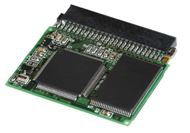Another portion of the internal memory found on the motherboard is called ROM. The ROM contains permanently recorded instructions that are vital for starting up a computer. One set of instructions found in ROM is called the ROM-BIOS, that stands for Read-Only Memory Basic Input-Output Services. These programs perform the most basic control and supervisory operations for the computer. For example, they check whether the I/O devices have been connected properly to the system unit. They also handle the basic needs of the hardware involved, which include all input and output devices. Any set of programs residing in ROM is called firmware.
Instructions in ROM can be executed but cannot be changed and hence the name Read-Only Memory. Further, these instructions are not erased when the power goes off. Therefore, ROM is said to be nonvolatile.
Note: In recent years, PCs have become increasingly memory-hungry, and the minimum desirable memory seems to go up every year. Now, 8 MB of memory is no longer considered large; it is the minimum required in most situations. Windows 3.1, for example, can function with 4 MB of RAM. However, it will spend a vast amount of time swapping data to disk unless you have a minimum of 8 MB of RAM.

